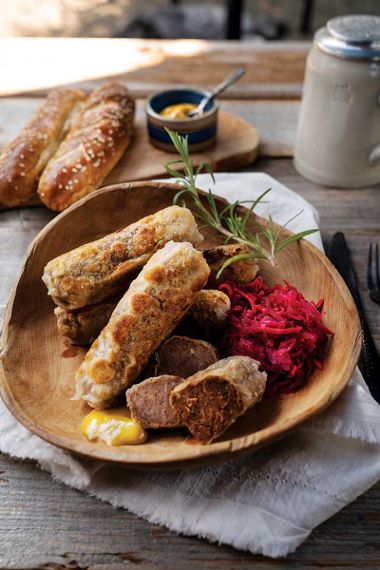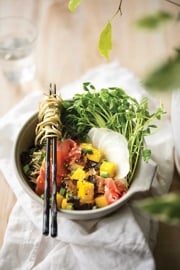A Unique Oktoberfest Menu—alive-Style!
The great German beer festival isn’t known for being particularly healthy. With iconic foods including sausages with sauerkraut and mustard, breaded meat schnitzel, fried potato balls stuffed with pork or beef, and giant, doughy pretzels made with refined white flour, the only green in sight is likely to be a parsley garnish.
But there’s no need to toss the bratwurst out with the bathwater. There are plenty of ways to add nutrition to your Oktoberfest menu. And these six heart-healthy versions of German recipes prove that flavour doesn’t just come from meat and oil.
Plant-based white bean and walnut bratwurst sausages can be grilled to smoky perfection, and seared tofu can make for crunchy-on-the-outside, tender-on-the-inside schnitzel. Meanwhile, spinach adds vitamins––along with a silky interior––to traditional potato dumplings, and a quick baking soda soak yields golden gluten-free, vegan pretzels.
Where did Oktoberfest come from? The history of the festival goes back to 1810, when Bavarian Prince Ludwig married Princess Therese. The party was such a hit that they made the event an annual tradition. Over the years, it kept getting longer (no one wanted the party to stop!) and its start date moved to the second-last weekend of September, with celebrations running until the first Sunday of October.
Anchored in tradition but updated for health, these alive-inspired recipes for some of the greatest Oktoberfest foods A unique Oktoberfest menu—alive-style! will have you wanting to extend the holiday, too!

The trick to these plant-based sausages is rolling them in rice paper wrappers before steaming and grilling them. The rice paper creates a translucent coating similar to sausage casing, but without pork. These are best served with grainy German mustard (preferably stone-ground) and sauerkraut (look for unpasteurized versions or make your own), but they’re also great sliced into pieces and cooked into a tomato-based barbecue sauce with curry powder—a traditional currywurst!

Schnitzel usually means tenderized meat coated in egg and breadcrumbs and deep-fried. The German version is often pork, while the Austrian wiener schnitzel has to be veal (it’s a rule). But this version of schnitzel would have even Julie Andrews singing its praises, thanks to the tender tofu that skips the fryer. Schnitzel can be served simply with noodles coated in (plant-based) butter with lemon wedges, but lingonberry sauce (reminiscent of cranberry sauce), tomato sauce, or mushroom gravy are also Oktoberfest regulars.

At Oktoberfest celebrations in Munich, there are always people walking around selling large pretzels, says Canadian expat Chris Gilles, who moved to the city in 2018. The large pieces of golden, twisted pretzel dough come topped with coarse salt for a savoury crunch with every bite. “They don’t come with any dipping sauce,” Gilles says, “but you could dip it in sauce if you had ordered something else”—say, the honey mustard or stone-ground mustard you might have with your bratwurst or sauerkraut balls. But don’t feel bad if you prefer to break from German tradition and dip them in caramel or tahini instead!

This dark beer-marinated chicken uses the convection setting on your oven to create a crispy skinned bird. Convection cooking circulates air around the meat, crisping it like rotisserie without needing a spit or a lot of oil, similar to an air fryer (which you can also use!). If you don’t have a convection setting on your oven, you can simply bake the chicken for longer at the same temperatures as below, until a meat thermometer inserted in the thickest part of the thigh reads 165 F (74 C).

Traditionally made with bratwurst and fried, these plant-based balls are baked and made with tempeh and mushrooms for a savoury, satisfying chewy interior and a crispy exterior. You can also use your homemade plant-based bratwurst as a stuffing in place of the croutons, but it seems a shame to go to all that work shaping them just to pull them apart.

"Germans do potatoes in general very well,” says Canadian expat Chris Gilles, who now lives in Munich and has celebrated many an Oktoberfest there. “Knödel seem kind of rubbery. You don’t really think it’s potato when you first see it, but it’s tasty.” But he might be surprised to find that this alive-inspired version of Bavarian potato dumplings is made with a combination of potato and cauliflower, because as anyone who’s eaten cauliflower gnocchi knows, the low-carb vegetable is a great way to lighten up starch-heavy foods (and Biergarten menus).
Magnificent mustard
Mustard is usually made from either whole or ground yellow, brown, or black mustard seeds, plus vinegar or water, salt, and other seasonings. The main differences come from the types of seeds used and how finely they’re ground.
Most commercial mustards are made with yellow or brown mustard seeds, though blends of two or three kinds are common, as it allows for a balance of flavour and heat. Vinegar reduces the heat slightly, but keeps mustard strongly flavoured. Water maintains the heat, but flavours fade faster, especially with hot water. These are some of the kinds of mustards you’re most likely to find:
Yellow mustard
Most people will recognize this mustard as the classic bright yellow squeeze bottle that lives in many a fridge and is a barbecue staple. As the name implies, it’s made from mostly yellow mustard seeds, but since yellow mustard seeds are generally less hot than other mustard seeds, other colours are often added for a touch more nose-tickling spice.
Grainy mustard
Rather than just one type of mustard, this is a group of mustards in which the seeds are left whole or cracked but not blended to a smooth consistency. The taste is often more pungent. Grainy mustards include creole, whole grain, and stone ground (though most mustards aren’t actually ground with stones anymore). These mustards are great for potato salads, sandwiches, or any dish where you want your mustard to have some texture.
Dijon mustard
Made with brown and black mustard seeds and white wine, Dijon mustard has a mild enough flavour to spread liberally on main dishes or add to just about anything without overpowering the main event, from salad dressing to grilled tempeh. It has a saltier, less acidic flavour than most yellow mustards.
Honey mustard
Easy to make at home, honey mustard is a one-to-one blend of honey (or another sweetener) and any kind of mustard (though it’s often yellow mustard). It’s great for marinades, dressings, and—our favourite—pretzels.
Spicy brown a.k.a. deli mustard
Made from brown mustard seeds (or blended with black for extra spice), this type of mustard is often spread on sandwiches. It has more texture than Dijon, but less than grainy mustards, and it’s usually seasoned with warm spices such as nutmeg, cinnamon, or ginger.
Hot mustard
Hot peppers aren’t added to hot mustard as the name implies (though some infused mustards do use chilies). Instead, the spiciness of the seeds themselves—think spicy wasabi or horseradish—aren’t dialled down by vinegar or hot water. These include Chinese mustards, which are known for their natural mustard seed heat and are good when used as dipping sauces for rich meat dishes.
German mustard
This is a blanket term for any mustard originating in Germany or made in a style that’s supposedly German (which unofficially means “good for eating with sausage”). Some Bavarian mustards are sweeter, some are spicier, and others fall somewhere in the middle.
Infused mustard
More and more mustards these days are being infused with spices, herbs, beers, and other flavours. A beer-infused mustard would be a great pairing for any of these recipes, while a sweeter flavour might be best for the gluten-free pretzels.





